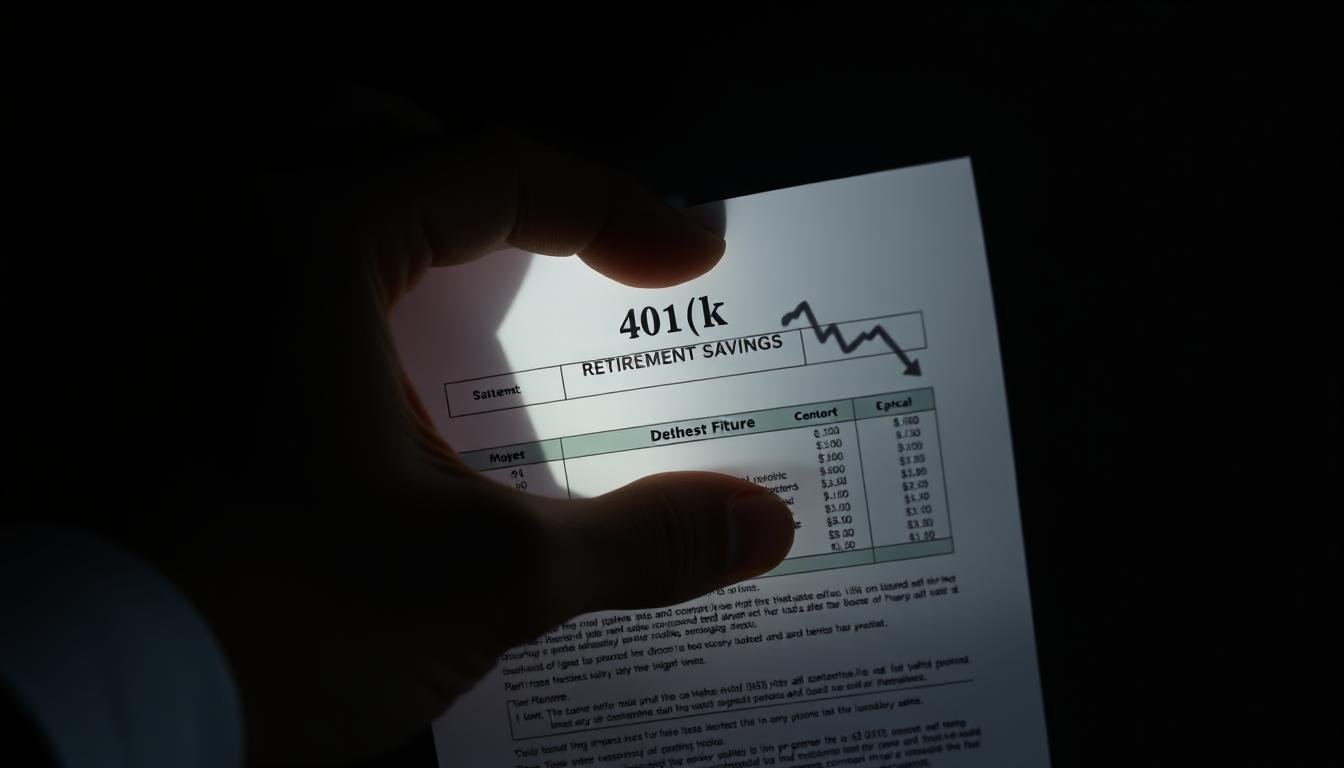I remember the panic in my inbox during the crash of 2020. Friends worried about their nest egg and whether a single bad month would ruin long-term dreams.
Short-term drops are normal in any market. Corrections over 10% happen every few years and can last months, while severe crashes are rarer but sharp. That history shows recovery can come fast, and panicked exits often lock in losses.
A clear, calm plan helps. Diversified allocations across stocks, bonds, and cash, steady contributions, and periodic rebalancing form a defense. Avoid tapping accounts early — taxes and a 10% penalty can set back future goals.
This guide will walk through practical moves on allocation, rebalancing, sector tilts, and cash buffers so your money can work toward retirement despite currency shifts. For more on how bear markets affect plans, see this guide on 401(k) behavior in bear.
Key Takeaways
- Short-term volatility is expected; long-term focus matters.
- Diversification and automatic contributions reduce risk.
- Rebalancing and target-date funds smooth recovery paths.
- Market timing often backfires; staying invested catches rebounds.
- Early withdrawals carry taxes and penalties that harm future savings.
Why a weaker currency matters for your retirement plan right now
Rising prices over time change how far retirement savings will stretch. Inflation reduces purchasing power, so each withdrawal buys less than it did years ago.
Inflation, purchasing power, and future withdrawals
Consumer prices track inflation. The CPI measures changes in a broad basket of goods and services. For example, a gallon of milk averaged about $2.70 in January 2000 and just over $4.00 in early 2025.
That rise means planners should model withdrawals for higher costs over time. Review contribution rates and expected spending so retirement income keeps pace with inflation.
Market volatility vs. economic recessions: key differences
Market moves can be fast; recessions are slower and deeper. Volatility reflects the speed of price swings and comes from politics, inflation data, GDP reports, sector shocks, and big-company news.
| Feature | Market volatility | Recession |
|---|---|---|
| Duration | Days to months | Months to years |
| Main drivers | News, earnings, policy | Declines in production, trade, jobs |
| Impact on investments | Sharp price swings; recovery possible | Wider economic damage; slower recovery |
Volatile periods don’t always mean a recession, and stock market dips can happen inside healthy economies. Investors should check their mix and time horizon rather than react to every downturn.
Is my 401(k) safe if the dollar keeps losing value?
A weaker currency can pinch purchasing power, but portfolio structure usually matters more than short-term price moves.
Short-term price swings vs. long-term market growth
Stocks face routine corrections and occasional crashes, yet broad markets have recovered over time. For example, the 2020 plunge gave way to a fast rebound. That history shows long-term returns depend on staying invested and keeping a plan.
Currency devaluation risk and the role of diversified assets
Diversification across stocks, bonds, and cash via mutual funds or ETFs helps limit how much one falling asset drags a portfolio down. Different assets react to rising prices and inflation in varied ways.
- Acknowledge pressure on purchasing power, but note that diversified exposure and a long-term approach reduce risk.
- Avoid concentration in a single stock; many advisers cap employer stock near 10%.
- Use rebalancing and dollar-cost averaging to keep risk aligned with goals and add shares during market dips.
| Action | Benefit | When to use |
|---|---|---|
| Diversify (stocks/bonds/cash) | Lower single-asset impact | Always |
| Limit employer stock | Reduce concentration risk | Ongoing |
| Rebalance | Maintain target risk | Annual or when allocation drifts |

No investment is risk-free, but a balanced asset mix and patience across the term of a retirement plan have historically supported better outcomes. Document a personal risk range and set guardrails so actions during bear markets match long-term goals.
Start with a plan: goals, time horizon, and risk tolerance
A practical roadmap starts with clear goals, a timeline, and an honest view of risk.
Begin by listing retirement targets in dollars and your expected monthly living expenses. That helps set contribution rates and an asset allocation that fits how many years remain before withdrawals begin.
Advisors often point to a simple rule such as stock percentage = 110 minus age (120 for aggressive, 100 for conservative). Use that rule only as a baseline. Tailor the percentage to personal goals, other assets, and appetite for volatility.

Setting targets and cash needs
Map out a realistic budget for retirement years and test scenarios for inflation. Stress-test withdrawals across down markets to see how long assets last.
Sequence-of-returns risk near retirement
Bad returns early in retirement can hurt long-term outcomes. Build a cash buffer and plan flexible withdrawals so you avoid selling equities at low prices. Rebalance annually or quarterly to keep allocations on track.
| Action | When | Why |
|---|---|---|
| Set dollar targets | Now | Align contributions to needs |
| Choose allocation | After targets | Match growth and safety |
| Create withdrawal plan | Pre-retirement | Reduce sequence risk |
| Rebalance policy | Annual/Quarterly | Maintain target assets mix |
Build resilient asset allocation for bull and bear markets
A smart mix of equities, fixed income, and cash keeps retirement plans on track through market turns.
Stocks supply long-term growth, while bonds add income and dampen swings. Cash covers near-term needs and gives dry powder to buy during selloffs.

Stocks, bonds, and cash: balancing growth and stability
Young savers often tilt toward stocks for growth. Those close to retirement shift toward bonds and cash to protect assets.
Target-date funds automate this glide path, easing allocation changes over time.
Diversification across asset classes, sectors, and funds
Use broad-market index funds and diversified active funds to spread exposure across sectors, styles, and regions.
Mutual funds and ETFs reduce single-stock swings and lower portfolio volatility across market cycles.
Limiting employer stock to reduce concentration risk
Keep employer holdings near a 10% cap to avoid heavy exposure to one company. This lowers one-source risk and helps preserve a retirement portfolio during company-specific shocks.
| Role | Purpose | When to emphasize |
|---|---|---|
| Stocks | Long-term growth | When time horizon is long |
| Bonds | Income and ballast | Near retirement or after large rallies |
| Cash | Short-term needs, rebalancing ammo | For living expenses and opportunistic buys |
| Funds (ETFs/Mutual) | Diversification across assets | Always as core building blocks |
Rebalance periodically to keep allocation targets intact. A disciplined policy prevents emotion-driven trades during rapid market moves.
Practical portfolio defenses: rebalancing, contributions, and DCA
A few disciplined habits help portfolios survive bouts of heavy market volatility and recover faster.
Rebalancing cadence and automated options
Set a regular rebalancing schedule. Rebalance at least annually; some advisers suggest quarterly. Target-date funds automate shifts and reduce risk as the target year nears.
Define drift thresholds—for example, 5%–10%—so you act on numbers, not emotion. Trades inside a retirement plan do not create a current tax bill, which makes routine adjustments easier.
Keep investing through downturns with dollar-cost averaging
Continue steady contributions during dips. Dollar-cost averaging helps you buy more shares when prices fall and avoids trying to time the bottom.
“Staying consistent during selloffs is often the single best way to improve long-term returns.”
Capture the employer match and tweak contributions as needed
Prioritize the full employer match. That match is reliable free savings and offsets rough market periods.
If cash is tight, trim contributions modestly but keep at least the match. That approach protects savings while preserving opportunity when markets recover.
- Set annual or quarterly rebalance cadence and use target-date funds if you prefer automation.
- Trigger rebalances at defined drift points to remove guesswork during volatility.
- Keep investing with DCA so you add shares in down markets.
- Confirm contribution level, capture full employer match, then review allocation drift and act.
Cash reserves and the bucket strategy for retirees
A deliberate cash reserve gives retirees breathing room when markets wobble.
How much cash on hand for living expenses
Keep one to three years of living expenses in liquid, short-term accounts. Some choose up to three to five years when income is uncertain or risk tolerance is low.
That buffer avoids selling long-term assets during a sharp market downturn. Use money market funds or short-term CDs for easy access and low volatility.
Three-bucket approach to avoid selling low
Bucket one holds cash or equivalent for immediate spending. Bucket two holds high-quality bonds to replenish cash over medium terms. Bucket three keeps stocks or growth assets for long-term gains.
This structure cuts sequence-of-returns risk: draw from cash when prices drop, then refill lower buckets after market recovery.
- Bucket 1: one–three years of living expenses in liquid funds.
- Bucket 2: short- to intermediate-term bonds for stability.
- Bucket 3: equities for growth and inflation protection.
Review this plan periodically and top up buckets after strong market periods. The right mix depends on retirement timing, pensions, and personal comfort with risk.
Smart moves during market stress without panic selling
When markets wobble, small tactical shifts can reduce downside without derailing plans.
Sector tilts that help in recessions
Consider modest tilts toward healthcare, utilities, and consumer staples. Demand in those areas tends to stay steadier during slow cycles. That can soften losses while you keep broad exposure.
Dividend payers and strong balance sheets
Favor quality stock with durable cash flow and low leverage. Firms that raise payouts for decades—like Dividend Aristocrats—can add income and stability in bear markets.
Also weigh small allocations to diversifiers such as gold or silver; these assets sometimes rise when risk aversion spikes (for example, metals moved higher in March 2023). Real estate can offer chances when prices fall, but only when cash flow and debt service remain solid.
- Keep any tilt modest so core allocation and long-term strategy stay intact.
- Avoid panic selling; rebalance into undervalued assets when it matches your plan.
- Use dividend and quality focus to help stabilize total returns.
Avoid costly mistakes: penalties, taxes, and timing errors
Quick reactions during a selloff can turn recoverable losses into permanent setbacks.
Before touching savings, remember early withdrawals often trigger a 10% IRS penalty plus income tax on traditional accounts. That erases compounding and reduces how much money you have over time.
Selling during a crash usually locks in losses and misses rebounds. Market timing based on short-term prices is risky; many who left after the 2020 plunge missed much of the recovery.
- Don’t cash out during a slide; penalties and taxes can erode savings and compound loss.
- Review employer stock exposure and trim toward a safe percentage to lower single-company risk.
- Most plan menus lack complex hedges; use diversified funds, bonds, or money market options for stability.
- Check expense ratios and fund overlap to avoid hidden concentration that hurts long-run returns.
Write a clear plan to guide actions during market volatility and consult a fiduciary advisor when tax rules or withdrawal choices feel unclear. For help on steps during big drops, see this guide on what to do when retirement accounts.
Conclusion
Small, consistent choices made today compound into a more secure retirement over years.
Rising prices and market volatility are real challenges, yet history shows invested stocks and a steady plan recover across bull and bear cycles.
Keep investing through cycles. Capture employer contributions, rebalance annually or quarterly, and hold diversified funds and assets to maintain allocation and risk.
Use bonds and money market options for near-term needs, while growth assets drive long-term returns. Keep a cash buffer or bucket plan to reduce sequence risk when nearing retirement.
Quarterly checklist: confirm contributions, review portfolio drift, rebalance if needed, and revisit withdrawal timing. For a short retirement planning checklist see retirement planning checklist.
Stay the course, follow your strategy, and focus on what you control today so money can compound toward a better future.
FAQ
How does a weaker dollar affect purchasing power for future withdrawals?
A declining greenback reduces what each retirement dollar buys. That raises the need to plan for higher living costs in retirement, by aiming for larger savings, targeting investments that historically outpace inflation, and reviewing withdrawal strategies to preserve real spending power.
What’s the difference between market volatility and a recession for retirement accounts?
Volatility means short-term ups and downs in prices. A recession is a broader, often longer economic slowdown with job losses and lower corporate profits. Volatility can be weathered with time and diversification; recessions can pressure income and returns, so having cash reserves and a clear allocation helps manage both.
Should I worry about currency devaluation risk inside my retirement portfolio?
Currency risk matters most for holdings tied to the dollar’s purchasing power. You can limit exposure by diversifying into asset classes that historically hedge inflation—like equities, Treasury Inflation-Protected Securities (TIPS), real assets, and certain commodities.
How do short-term price swings compare with long-term market growth for retirees?
Short-term swings can be dramatic but rarely alter long-term compound returns for well-diversified portfolios. If your time horizon is long, staying invested usually benefits growth. If you are near or in retirement, shifting some assets to stable buckets reduces the chance of selling at a loss.
What retirement planning steps should I take given inflation and currency concerns?
Start with clear goals and a realistic timeframe. Calculate expected living expenses, factor inflation into projections, set a target replacement rate, and align your risk tolerance with a diversified allocation. Review annually and adjust contributions or asset mix as needed.
How can sequence-of-returns risk hurt those nearing retirement?
If big market losses occur just before or during early retirement, withdrawals from a shrinking portfolio can permanently reduce lifetime income. Mitigate this by holding cash for near-term needs, using conservative bond allocations, and delaying large withdrawals if feasible.
What mix of stocks, bonds, and cash balances growth and stability?
There’s no one-size-fits-all answer. Younger investors may favor a higher equity percentage for growth. Near-retirees typically increase bonds and cash to protect capital. Target-date funds, customized glide paths, or a three-bucket plan can formalize that balance.
How does diversification across sectors and funds protect against dollar weakness?
Diversifying into different industries, international equities, and inflation-linked securities spreads risk. Some sectors—energy, materials, real estate—tend to perform better during inflationary periods. Global exposure can also reduce reliance on any single currency.
Should I limit employer stock within a retirement plan?
Yes. Heavy holdings in employer stock concentrate company and market risk. Selling or gradually diversifying large employer positions lowers the chance that a single employer’s troubles will derail retirement savings.
How often should I rebalance my portfolio during uncertain times?
Rebalancing annually is a simple, effective cadence for many. More active investors may rebalance quarterly or when allocations drift beyond set thresholds. Target-date funds automate rebalancing for hands-off investors.
Is dollar-cost averaging (DCA) still useful in volatile markets?
Yes. Regular contributions through DCA reduce timing risk and can lower average purchase prices during dips. Continuing to invest, especially to capture employer matches, remains an important discipline in choppy markets.
How much cash should I keep for living expenses in retirement?
A common rule is to hold one to three years of living expenses in cash or short-term bonds, depending on risk tolerance and market conditions. That buffer helps avoid selling investments during market lows.
What is the three-bucket strategy and how does it help retirees?
The three-bucket approach separates short-term cash needs, intermediate income assets, and long-term growth investments. It reduces the chance of selling growth assets at a loss and smooths income while preserving upside potential.
Which sectors tend to be resilient during recessions?
Defensive sectors—healthcare, utilities, and consumer staples—often hold up better because demand for their goods and services remains steady. Allocating a portion of equities to these sectors can add stability.
Are dividend-paying stocks helpful when markets are rough?
Dividend payers with strong balance sheets can provide income and downside cushion. Focus on quality companies with sustainable payouts rather than chasing high yields from risky firms.
How can I avoid costly mistakes like tax penalties and bad timing?
Avoid early withdrawals from tax-advantaged accounts, understand RMD rules, and consult a tax advisor before large moves. Maintain a plan to prevent panic selling during downturns and use dollar-cost averaging to reduce timing risk.
Should I change contributions during volatile markets?
Don’t stop contributions if you can afford them. Continue to capture employer matches and consider modest increases if pay allows. If cash flow is tight, temporarily reducing contributions is better than dipping into retirement savings early.
How do I monitor and adjust a portfolio as inflation and markets evolve?
Review allocations annually, stress-test goals against higher inflation scenarios, and rebalance when allocations drift. Work with a financial planner if your situation or goals change significantly.

